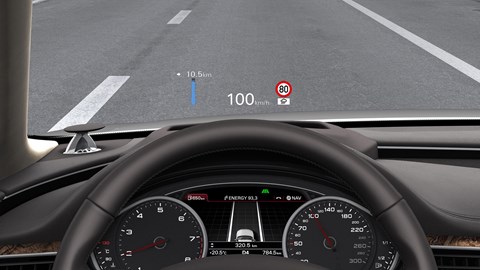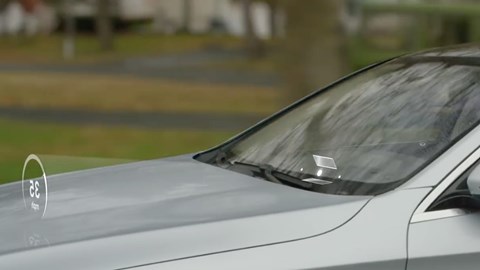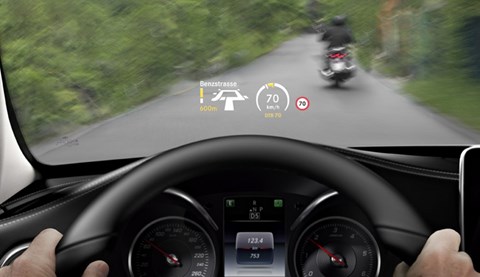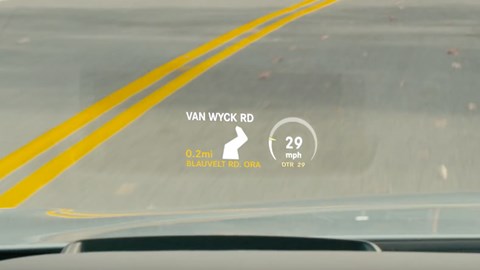► The future of head-up displays
► How do HUDs work in cars?
► Should you spec them?
BMW has confirmed it will launch a full-width head-up display (HUD) in its innovative new Neue Klasse electric saloon in 2025 – bringing a dose of sci-fi to the mainstream.
Manufacturers have talked for years of augmented reality coming to cars and BMW’s Panoramic Vision is the biggest leap forwards we’ve yet seen. The new mid-sized EV will have a projection running the full width of the windscreen, beaming important information on to the glass for all occupants to see.
The new set-up is enabled by a dark-coated strip across the bottom of the screen, meaning that the image is pin-sharp in all light conditions, according to Munich. Official images from BMW show speed, gear selection, infotainment, sat-nav and time being shown.
Read on for more background on head-up displays.
Head-up displays (HUD): what you need to know
If you’re in the market to buy a new car, you may have noticed a head-up display on the options list – especially if you’re looking at anything remotely high-end. Originally used in fighter jets, HUDs are now making their way into more mainstream cars’ interiors, and are touted by manufacturers as a feature that makes driving both easier and safer.
You’ll find head-up display technology in everything from the BMW i8 Roadster to the new Audi A7 – but just how does it work, and is it even worth the money? Keep reading to find out everything you need to know about head-up displays in cars – and if they’re worth your cash.
The best aftermarket head-up displays

How does a car head-up display (HUD) work?
Head-up displays are able to beam a floating image of information you’d find useful when driving directly ahead of the windscreen. For example, most head-up displays will project everything from speed and cruise control settings to directions and speed limits directly into the driver’s view.
What are the levels of autonomous vehicle? Read the CAR guide here
Essentially, HUDs work by projecting a reversed image on to the windscreen, which is then reflected directly into the driver’s eyeline. Cars with a head-up display will often feature a strange rectangular shape on the top of the dashboard ahead of the dials; this is where the image is actually shone from.

The head-up displays mentioned in this article are built-in, but in 2018 you can also buy aftermarket HUD systems to retrofit in older vehicles.
Is a head-up display worth the money when I’m speccing my next car?
Head-up displays can be viewed as either an interesting gimmick, or a useful safety feature – and we think they’re the latter. While they seem the stuff of sci-fi, they actively reduce the time a driver takes their eyes off the road. Once you live with one for a while, you’ll be loathe to go back, in our experience…
Modern infotainment screens are great. Many can be anything over 10-inches, feature HD content and display a wealth of information – but they still require drivers to take their eyes off the road, and that’s as dangerous as it sounds.

Often you’ll only need a quick look, but those constant glances add up over the course of a long journey – and any one of them could potentially cause an accident. What’s more, at motorway speeds, those split seconds will translate to greater distances, giving you less time to react to any hazards.
By providing the information you need where you’re likely to look, HUDs stop you peering down at infotainment screens or dials – and therefore allow you to concentrate fully on assessing your surroundings.

How much does a head-up display cost then?
The price of head-up displays vary, but you’ll be paying around £1000 if you want a car with the technology. For example, Audi will sell you a HUD for your A4 for just £900, while you’ll have to cough up £1495 to get the same tech in a BMW 520i – though you also get wireless phone charging, Wi-Fi hotspot preparation, gesture control and a key with display on a 5er.
Similarly, you’ll have to pay £1275 to get a HUD on a new Volvo XC90 as part of the Winter pack, but that also comes with a heated steering wheel as well as heated washer nozzles and a headlight cleaning system.It seems a lot of manufacturers prefer to bundle this projecting tech into an options package, rather than sell them individually.
Read more tech stories by CAR magazine here